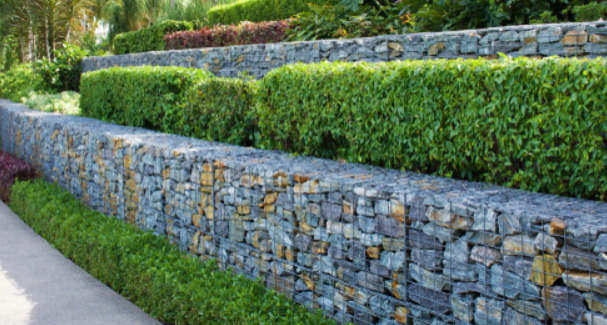Retaining walls are essential structures in landscaping, designed to hold back soil and prevent erosion. They not only serve a functional purpose but also add aesthetic value to your property. Building a retaining wall requires careful planning, design, and construction, which is why hiring the right retaining wall builder is crucial.
This guide will help you understand the importance of retaining walls, the different types of retaining walls, what to look for in a builder, and how to ensure your project is successful.
Understanding Retaining Walls
1. What is a Retaining Wall?
A retaining wall is a structure designed to resist the lateral pressure of soil when there is a change in ground elevation. These walls are commonly used in landscaping to create level areas on sloped terrain, prevent erosion, and enhance the visual appeal of a garden or yard.
2. Types of Retaining Walls
Gravity Retaining Walls
These walls rely on their own weight to hold back the soil. They are typically made of heavy materials such as stone, concrete, or brick. Gravity walls are ideal for short walls and are often used in residential landscaping.
Cantilevered Retaining Walls
Cantilevered walls are constructed from reinforced concrete and are designed to withstand significant pressure. They consist of a vertical stem and a horizontal base slab that extends into the ground, providing stability. These walls are commonly used in commercial and residential projects where higher walls are required.
Sheet Pile Retaining Walls
Sheet pile walls are made from steel, vinyl, or wood planks that are driven into the ground. They are often used in areas with soft soil or where space is limited. These walls are suitable for both temporary and permanent applications.
Anchored Retaining Walls
Anchored walls use cables or other types of support anchored into the ground behind the wall. This type of wall is ideal for supporting heavy loads and can be used in a variety of settings, including residential and commercial projects.
Segmental Retaining Walls
Segmental retaining walls are made from interlocking concrete blocks that are stacked without the need for mortar. These walls are popular in residential landscaping due to their flexibility, ease of installation, and aesthetic appeal.
The Importance of Hiring a Professional Retaining Wall Builder
1. Expertise and Experience
Building a retaining wall requires specialized knowledge and experience. A professional retaining wall builder in Wollongong understands the complexities of soil mechanics, drainage, and structural integrity. They can assess your property’s needs and design a wall that is both functional and visually appealing.
2. Proper Design and Engineering
A well-designed retaining wall must consider factors such as soil type, slope, water drainage, and load-bearing capacity. Professional builders have the engineering expertise to design walls that can withstand these challenges, ensuring long-term stability and safety.
3. Quality Materials
Choosing the right materials is crucial for the longevity of your retaining wall. Professional builders have access to high-quality materials and can recommend the best options based on your project’s requirements, whether it’s natural stone, concrete, or timber.
4. Compliance with Local Regulations
Building a retaining wall often requires permits and must comply with local building codes. A professional builder is familiar with these regulations and can ensure that your project meets all necessary requirements, avoiding potential legal issues.
5. Cost-Effective Solutions
While hiring a professional may seem more expensive upfront, it can save you money in the long run. Professional builders can prevent costly mistakes, ensure efficient use of materials, and complete the project within budget and on time.
How to Choose the Right Retaining Wall Builder
1. Research and Recommendations
Start by researching local retaining wall builders. Ask for recommendations from friends, family, or neighbors who have had similar work done. Online reviews and testimonials can also provide valuable insights into a contractor’s reputation and quality of work.
2. Check Credentials and Experience
Ensure that the builder is licensed, insured, and has the necessary certifications to perform the work. Experience is crucial, so look for a builder who has a proven track record in constructing retaining walls similar to the one you need.
3. Review Past Projects
Ask to see a portfolio of the builder’s past projects. This will give you an idea of their style, quality of work, and the types of retaining walls they specialize in. Visiting completed projects in person, if possible, can also provide a better sense of their craftsmanship.
4. Get Multiple Quotes
Obtain detailed quotes from at least three different builders. Compare the scope of work, materials, timeline, and costs. Be wary of quotes that are significantly lower than others, as this may indicate lower quality materials or workmanship.
5. Ask About Warranties and Guarantees
A reputable retaining wall builder should offer warranties on their workmanship and the materials used. Ask about the terms of these warranties and what is covered. This will give you peace of mind knowing that your investment is protected.
6. Communication and Professionalism
Choose a builder who communicates clearly and professionally. They should be willing to answer your questions, provide regular updates, and work with you to address any concerns throughout the project. Good communication is key to a successful partnership.
The Retaining Wall Construction Process
1. Initial Consultation and Site Assessment
The process begins with an initial consultation where the builder will assess your property, discuss your needs, and provide recommendations for the type of retaining wall that would best suit your landscape. They will also evaluate the soil conditions, slope, and drainage requirements.
2. Design and Planning
Once the site assessment is complete, the builder will create a detailed design for the retaining wall. This may include engineering drawings, material selection, and a construction plan. The design phase is crucial for ensuring that the wall will be structurally sound and aesthetically pleasing.
3. Obtaining Permits
Depending on the scope of the project and local regulations, you may need to obtain permits before construction can begin. The builder will assist with this process, ensuring that all necessary approvals are in place.
4. Site Preparation
Before construction begins, the site must be prepared. This includes clearing the area of vegetation, debris, and any existing structures. The builder will also excavate the site to create a level foundation for the wall.
5. Foundation and Base Construction
A solid foundation is essential for the stability of the retaining wall. The builder will construct a base using compacted gravel or concrete, depending on the design and materials used. This base will provide support and prevent the wall from shifting over time.
6. Wall Construction
With the foundation in place, the builder will begin constructing the wall. The process varies depending on the type of retaining wall but typically involves stacking or laying materials, reinforcing the structure, and ensuring proper drainage.
7. Drainage System Installation
Proper drainage is critical to the longevity of a retaining wall. The builder will install a drainage system, such as weep holes, gravel backfill, or perforated pipes, to prevent water from building up behind the wall and causing damage.
8. Finishing Touches and Landscaping
Once the wall is constructed, the builder will complete any finishing touches, such as capping the wall with stone or concrete and integrating it with the surrounding landscape. They may also add features such as lighting, stairs, or planters to enhance the wall’s appearance.
9. Final Inspection and Approval
After construction is complete, the builder will conduct a final inspection to ensure that the wall meets all design specifications and safety standards. You will then have the opportunity to review the work and provide your approval.
Maintaining Your Retaining Wall
1. Regular Inspections
Inspect your retaining wall regularly for signs of damage, such as cracks, bulging, or leaning. Early detection of issues can prevent more significant problems and costly repairs.
2. Addressing Drainage Issues
Ensure that the drainage system is functioning correctly. Clear any blockages in weep holes or drainage pipes to prevent water from accumulating behind the wall.
3. Cleaning and Landscaping
Keep the area around the retaining wall clean and free of debris. Regularly trim vegetation that may be growing near or on the wall, as roots can cause damage over time.
4. Repairs and Maintenance
If you notice any damage or wear, contact a professional retaining wall builder to assess and repair the issue. Regular maintenance will help extend the life of your wall and maintain its structural integrity.
Conclusion
Building a retaining wall is a significant investment that requires careful planning, design, and construction. By hiring a professional retaining wall builder, you can ensure that your project is completed to the highest standards, providing both functional and aesthetic benefits to your property. Remember to research potential builders thoroughly, review their credentials and experience, and communicate clearly throughout the process. With the right builder and proper maintenance, your retaining wall will stand the test of time and enhance the beauty of your landscape for years to come.









